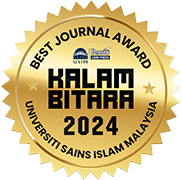FAITH-BASED MEDIATION: A COMPARATIVE PERSPECTIVE ON THE APPLICATION OF SULH AND HO’OPONOPONO
DOI:
https://doi.org/10.33102/mjsl.v7i1.88Keywords:
Dispute Resolution, Mediation, Sulh, Ho’oponoponoAbstract
The application of mediation can be traced in many culture and tradition across the world. Closely related to the faith of the people, mediation has essential roles in resolving disputes among the members of the society. While the faith-based mediation of Ho’oponopono is famous in Hawaii, the faith-based mediation of Sulh is famous among Muslims in South East Asia. The dispute resolution strategies which are used in Ho’oponopono and Sulh are comparatively analysed in this research. The practices of Sulh are evaluated based on empirical findings collected from Pasir Mas (Kelantan, Malaysia) and Indragiri Hilir (Riau, Indonesia). Meanwhile, the qualitative findings on practices of Ho’oponopono are collected from earlier researches that utilised empirical investigations. By employing a qualitative doctrinal analysis, this research identifies similarities and differences of faith- based mediations of Sulh and Ho’oponopono. At the same time, the said faith-based mediations’ potentials and challenges are explored. Focusing on an expeditious resolution, it is found that faith-based mediations are still applied among the members of the society in Malaysia, Indonesia and Hawaii.Downloads
References
Abdul Wahab, Alwi. (2013). Court-Annexed and Judge-led Mediation in Civil Cases: The Malaysian Experience. (Ph.D Thesis, College of Law and Justice Victoria University of Melbourne).
Abraham, C. (2006). Alternative dispute resolution in Malaysia. 9th ALA General Assembly–ASEAN Law Association, 2.
Bastin J., and Winks, R. W. (1966). Malaysia: Selected Historical Readings. (Kuala Lumpur: Oxford University Press).
Boardman, S. K., & Horowitz, S. V. (1994). Constructive conflict management and social problems: An introduction. Journal of social issues, 50(1), 1-12.
Boggs, S. T., & Chun, M. N. (1990). Ho'oponopono: A Hawaiian method of solving interpersonal problems. Disentangling: Conflict discourse in Pacific societies, 122-160.
Castro, A. P., & Nielsen, E. (2001). Indigenous people and co-management: implications for conflict management. Environmental Science & Policy, 4(4-5), 229-239.
Emory, K. P. (1965). Kapingamarangi, social and religious life of a Polynesian Atoll. The Museum.
Hickling, R. H. (2001). Malaysian Law: An introduction to the concept of law in Malaysia. Pelanduk Publications.
Hisyam, M. (2005). Potret Penghulu dalam naskah Sebuah pengalaman penelitian. Wacana, 7(2), 129-137.
Hosmanek, A. J. (2005). Cutting the cord: Ho'oponopono and Hawaiian restorative justice in the criminal law context. Pepp. Disp. Resol. LJ, 5, 359.
Kamhis, J. (1992). Healing with Hawaiian ho'oponopono. Aloba, July/August, 44-49.
Kirch, P. V. (1989). The evolution of the Polynesian chiefdoms. Cambridge University Press.
Legal Aid Society of Hawaii. Official Website. Retrieved from http://hawaiianbar.org/http://www.legalaidhawaii.org/
Mohd. Zain, N. R., & Ahmadi, F. (2016). Traditional Roles of Penghulu in
Resolution of Disputes: A Comparative Study from Pasir Mas, Kelantan
(Malaysia) and Indragiri Hilir, Riau (Indonesia). Journal of Asian and
African Social Science and Humanities, 2 (2), 103-112.
Muhammad, R. W. (2011). The administration of Syariah Courts in Malaysia, 1957–2009. Journal of Islamic Law and Culture, 13(2-3), 242-252.
Native Hawaiian Bar Association. 2019. Official Website. Retrieved from http://hawaiianbar.org/
Pryles, M. C. (Ed.). (2006). Dispute resolution in Asia. Kluwer Law International.
Pukui, M. K., Haertig, E. W., & Lee, C. A. (1972). Nana i ke Kumu. Honolulu: Hui Hanai, 1, 35-40.
Ramli, M. A. (2010). Pemikiran mesra gender dalam karya fiqh ulama Melayu klasik. Jurnal Syariah, 18 (2), 277-298.
Riskin, L. L., & Westbrook, J. E. (1987). Dispute Resolution and Lawyers. West Group.
Suarez, T. (2012). Early mapping of Southeast Asia: the epic story of seafarers, adventurers, and cartographers who first mapped the regions between China and India. Tuttle Publishing.
Syed Hassan, S. Z., & Cederroth, S. (1997). Managing Marital Disputes in Malaysia: Islamic Mediators and Conflict Resolution in Syariah Courts. (London: Curzon Press).
The Guardian. 2017. “History, harmony, and the only Muslim Island in Australiaâ€. 29 January 2017. https://www.theguardian.com/travel/2017/jan/29/history-harmony-and-the-only-muslim-island-in-australia
Wall Jr, J. A., & Callister, R. R. (1995). Conflict and its management. Journal of management, 21(3), 515-558.
Downloads
Published
Issue
Section
License
Copyright (c) 2019 Nor Razinah Mohd Zain, Faisal Ahmadi, Lia Sautunnida

This work is licensed under a Creative Commons Attribution-NonCommercial 4.0 International License.














































